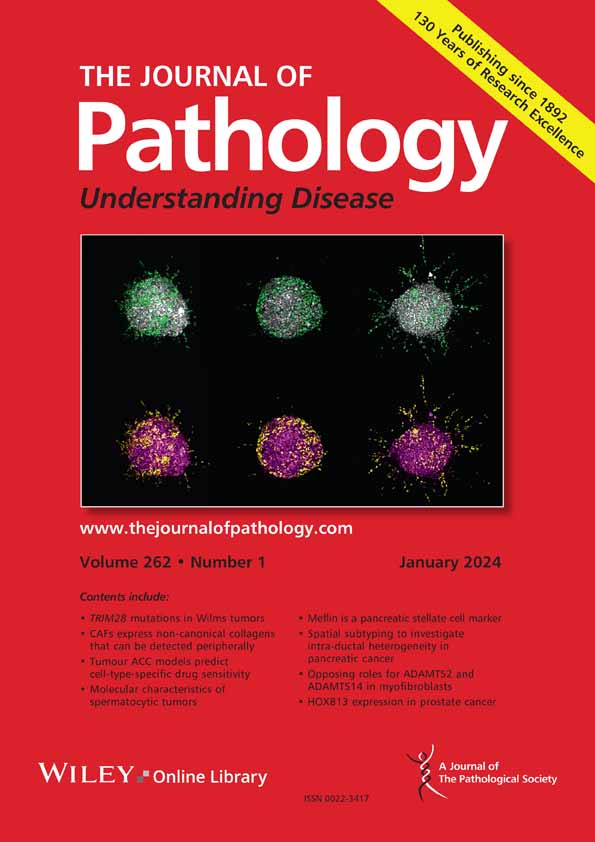Yuyao Feng, Yunfei Xue, Xiaohang Feng, Zhiwei Li, Luxia Ren, Wenjun Guo, Yangfeng Hou, Ting Shu, Wensi Zhang, Yang Yang, Yitian Zhou, Kai Song, Jiang Xiong, Bao Liu, Jing Wang, Hongmei Zhao
求助PDF
{"title":"Phosphodiesterase 5 inactivation in vascular smooth muscle cells aggravates aortic aneurysm and dissection","authors":"Yuyao Feng, Yunfei Xue, Xiaohang Feng, Zhiwei Li, Luxia Ren, Wenjun Guo, Yangfeng Hou, Ting Shu, Wensi Zhang, Yang Yang, Yitian Zhou, Kai Song, Jiang Xiong, Bao Liu, Jing Wang, Hongmei Zhao","doi":"10.1002/path.6411","DOIUrl":null,"url":null,"abstract":"<p>Aortic aneurysm and dissection (AAD) are vascular disorders with high mortality. Previous evidence has suggested an elevated risk of AAD associated with the use of phosphodiesterase 5A (PDE5A) inhibitors. PDE5A, a cGMP-hydrolyzing enzyme, is enriched in vascular smooth muscle cells (SMCs), but the role of SMC-specific PDE5A in the pathogenesis of AAD is still unclear. In this study, PDE5A expression in human and mouse aortic tissues was analyzed by single-cell RNA sequencing (scRNA-seq), western blotting, immunofluorescence, and immunohistochemistry staining. SMC-specific PDE5A knockout (PDE5A<sup>SMC−/−</sup>) and PDE5A-overexpressing (PDE5A<sup>SMC-OE</sup>) mice were constructed and utilized, along with an AAD mouse model induced by a high-fat diet and angiotensin II (Ang II) infusion. <i>In vivo</i> imaging and histological analyses were performed to assess aortic pathologies. PDE5A expression was reduced in human and mouse AAD aortic tissues, primarily in SMCs. Pharmacological inhibition or genetic knockout of PDE5A in SMCs exacerbated aortic wall dilatation and elastin fiber degradation, increasing AAD incidence. In contrast, the AAD phenotype was rescued in challenged PDE5A<sup>SMC-OE</sup> mice. Mechanistically, PDE5A expression influenced myosin light chain (MLC) phosphorylation, a key regulator of SMC contractility. In AAD tissues from PDE5A<sup>SMC−/−</sup> mice, increased cGMP-dependent protein kinase (PKG) activation and decreased MLC phosphorylation indicate enhanced aortic relaxation. In conclusion, our findings suggest that PDE5A downregulation or inhibition plays a causative role in exacerbating AAD likely by potentiating cGMP/PKG-mediated aortic SMC relaxation. Our findings highlight the need for caution in the clinical use of PDE5 inhibitors in patients at risk of aortic diseases. © 2025 The Pathological Society of Great Britain and Ireland.</p>","PeriodicalId":232,"journal":{"name":"The Journal of Pathology","volume":"266 2","pages":"144-159"},"PeriodicalIF":5.2000,"publicationDate":"2025-03-27","publicationTypes":"Journal Article","fieldsOfStudy":null,"isOpenAccess":false,"openAccessPdf":"","citationCount":"0","resultStr":null,"platform":"Semanticscholar","paperid":null,"PeriodicalName":"The Journal of Pathology","FirstCategoryId":"3","ListUrlMain":"https://pathsocjournals.onlinelibrary.wiley.com/doi/10.1002/path.6411","RegionNum":2,"RegionCategory":"医学","ArticlePicture":[],"TitleCN":null,"AbstractTextCN":null,"PMCID":null,"EPubDate":"","PubModel":"","JCR":"Q1","JCRName":"ONCOLOGY","Score":null,"Total":0}
引用次数: 0
引用
批量引用
Abstract
Aortic aneurysm and dissection (AAD) are vascular disorders with high mortality. Previous evidence has suggested an elevated risk of AAD associated with the use of phosphodiesterase 5A (PDE5A) inhibitors. PDE5A, a cGMP-hydrolyzing enzyme, is enriched in vascular smooth muscle cells (SMCs), but the role of SMC-specific PDE5A in the pathogenesis of AAD is still unclear. In this study, PDE5A expression in human and mouse aortic tissues was analyzed by single-cell RNA sequencing (scRNA-seq), western blotting, immunofluorescence, and immunohistochemistry staining. SMC-specific PDE5A knockout (PDE5ASMC−/− ) and PDE5A-overexpressing (PDE5ASMC-OE ) mice were constructed and utilized, along with an AAD mouse model induced by a high-fat diet and angiotensin II (Ang II) infusion. In vivo imaging and histological analyses were performed to assess aortic pathologies. PDE5A expression was reduced in human and mouse AAD aortic tissues, primarily in SMCs. Pharmacological inhibition or genetic knockout of PDE5A in SMCs exacerbated aortic wall dilatation and elastin fiber degradation, increasing AAD incidence. In contrast, the AAD phenotype was rescued in challenged PDE5ASMC-OE mice. Mechanistically, PDE5A expression influenced myosin light chain (MLC) phosphorylation, a key regulator of SMC contractility. In AAD tissues from PDE5ASMC−/− mice, increased cGMP-dependent protein kinase (PKG) activation and decreased MLC phosphorylation indicate enhanced aortic relaxation. In conclusion, our findings suggest that PDE5A downregulation or inhibition plays a causative role in exacerbating AAD likely by potentiating cGMP/PKG-mediated aortic SMC relaxation. Our findings highlight the need for caution in the clinical use of PDE5 inhibitors in patients at risk of aortic diseases. © 2025 The Pathological Society of Great Britain and Ireland.






 求助内容:
求助内容: 应助结果提醒方式:
应助结果提醒方式:


